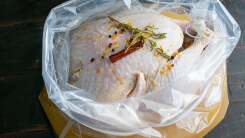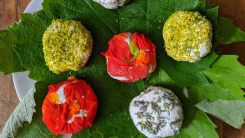‘Cage-Free’ Is Basically Meaningless, and Other Lies Your Egg Carton Is Telling You
Eggs are both simple and complex. They’re one of the easiest foods you can learn how to cook, but can be prepared in a seemingly endless amount of interesting and complex ways. From a chemical perspective, they are absolutely bonkers, packed with all sorts of proteins, lipids, carbohydrates, and (some) minerals. And, with two distinct portions, they’re practically a two-for-one food.
Eggs come from chickens, the diet and treatment of which can also affect the taste and nutritional content of the egg. All the language you see printed on a carton of eggs is supposedly there to help you make your egg-related purchasing decisions, but some of those words are more helpful than others.
Egg words that mean absolutely nothing
These are the words you should ignore, as they are mere marketing terms with no real value.

Fresh or Farm Fresh: Even if the eggs were processed, packaged, and shipped out the moment they exited the chicken, this phrase would lose meaning with each passing moment. (The FDA grading system accounts for freshness anyway. More on that in a moment.)
Natural: No egg is unnatural—that is the nature of eggs.
Hormone-Free or No Added Hormones: The FDA banned the use of added hormones in egg-producing chickens over 60 years ago. Hormones are found in all living things but, according to upcertified.com, “no growth or production hormones are ever fed to pullets (younger hens) being grown to be egg-laying hens nor during the egg-laying period.”
Egg words that technically mean something but aren’t that helpful
These are words and phrases that may be technically correct, but shouldn’t necessarily influence you when buying eggs.
Brown: This tells you is the color of the eggshell, which you can figure out on your own if you open the carton. Shell color has no effect on taste or nutritional value.
Omega-3: The chicken that laid the egg ate something that contained omega-3 fatty acids, but that does not guarantee a significant amount of that acid made its way into the egg.
Cage Free: The birds that laid these eggs weren’t kept in cages, but that doesn’t mean they ever went outside, or weren’t crammed into an overpopulated barn.
Fertile: These chickens fucked. (There is no proven nutritional benefit to this.)
Egg words that could actually tell you something about the egg (or the chicken that laid it)
Finally, some helpful information!
Free Range: According to certifiedhumane.org, the USDA’s requirement for “Free Range” is “outdoor access” or “access to the outdoors.” “In some cases, this can mean access only through a “pop hole,” with no full-body access to the outdoors and no minimum space requirement.” If, however, your eggs come with the HFAC’s Certified Humane® “Free Range” label, that means the hens had access to two square feet of outside space per bird, and were outside for at least six hours per day, weather permitting.
Pasture Raised: Similar to “Free Range” there is no strict legal definition of this term, but the HFAC Certified Humane® “Pasture Raised” requirement is very precise. If you see this label, it means that there were no more than “1000 birds per 2.5 acres (108 sq. ft. per bird),” and that the fields they lived in were rotated. According to certifiedhumane.org, “The hens must be outdoors year-round, with mobile or fixed housing where the hens can go inside at night to protect themselves from predators, or for up to two weeks out of the year, due only to very inclement weather.”
Pesticide-Free: Pesticides weren’t used to grow the food the chickens eat.
Vegetarian: The chickens did not eat any meat, but this means they did not eat any worms, which means they were not pecking around outside in the dirt.
No Antibiotics: According to The Atlantic, “this labeling term means that farmers used no antibiotics in the hens’ feed or water during growing periods or while hens are laying the eggs.” This doesn’t have an immediate effect on the quality or flavor of the egg you’re eating, but buying eggs that were produced without the use of antibiotics supports farmers who “are losing some of them to disease in service of the greater idea that antibiotic overuse leads to superbugs.” In other words: Fewer antibiotics lead to fewer antibiotic-resistant bacteria, and antibiotic-resistant bacteria are not the kind of bacteria you want to encourage.
What about “organic”?
According to organicconsumers.org the USDA’s “National Organic Program,” requires that organic eggs “come from chickens that are raised cage-free, fed an organic diet grown without pesticides, managed without antibiotics and hormones, and have seasonal access to the outdoors.” But things can get tricky when it comes to outdoor access.
As you can see from the above 2018 PBS segment, the farms that “organic” eggs come from can look wildly different. Some hens do indeed get to live a life that looks like something out of a child’s storybook, foraging around in the soil and sun, while others spend most of their lives in barns, taking their “outdoor” time on porches.
That could change, however, as the Biden administration is reconsidering the previous administration’s interpretation that the USDA doesn’t have the authority to mandate animal welfare conditions. This would “disallow the use of porches as outdoor space in organic production over time.”
It is worth noting, however, that some experts, like the Doctor of Veterinarian Medicine interviewed by PBS for the segment above, argue that keeping hens in enclosures such as porches is safer, as it prevents them from being infected by wild birds.
If you are concerned about the amount (and type) of space egg-producing hens have, you can consult the Cornucopia Institute’s Organic Egg Scorecard, which rates egg brands with the “organic” label on a scale from one to five eggs based on access to outdoor space, amount of indoor and outdoor space, pasture rotation, and transparency.
Size and grading
Two of the most common and easily understood markings you’ll find on a carton of eggs are its grade and size. The according to the USDA, There are three consumer grades for eggs:
United States (U.S.) Grade AA, A, and B. The grade is determined by the interior quality of the egg and the appearance and condition of the egg shell. Eggs of any quality grade may differ in weight (size). U.S. Grade AA eggs have whites that are thick and firm; yolks that are high, round, and practically free from defects; and clean, unbroken shells.
Freshness also plays a role in determining the grade, with the USDA simply stating that only the “freshest and highest quality eggs will receive a Grade AA.” All whole eggs sold in grocery stores are almost always Grade A or AA; Grade B eggs are sold a dried, frozen, and dried egg products.
Egg sizes range all the way from “peewee” to “jumbo,” with the size being determined by the average weight of a dozen:
Peewee eggs must be a minimum of 15 ounces per dozen.
Small eggs must be a minimum of 18 ounces per dozen.
Medium eggs must be a minimum of 21 ounces per dozen.
Large eggs must be a minimum of 24 ounces per dozen.
Extra-large eggs must be a minimum of 27 ounces per dozen.
Jumbo eggs must be a minimum of 30 ounces per dozen.
Most eggs sold in grocery stores are large or extra-large, though it is possible to find a medium egg in a carton that is labeled “large,” as long as the average weight of all 12 eggs works out to 24 ounces or greater.
If all of this seems like too much to remember, you can always build a coop and raise your own hens, or source your eggs from a local farm. The yolks in local farm eggs have a darker color and richer flavor than factory farmed eggs, and come with a nice smug feeling of moral superiority. (My favorite eggs come from my dad’s chickens, but Vital Farms, which is rated very highly on ol’ Organic Egg Scorecard, are a very close second).









Comments on "‘Cage-Free’ Is Basically Meaningless, and Other Lies Your Egg Carton Is Telling You" :